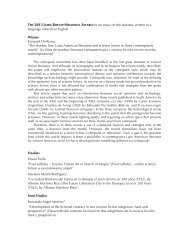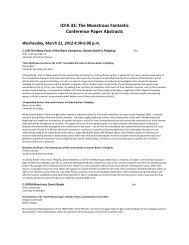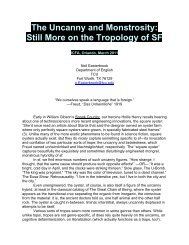legs and feet; the “Dancing Faun” sculpture after which the 2 nd century B.C.E. house in Pompeii—the House of the Faun—is named shows thefaun with only horns and a short tail to distinguish him from other human males. <strong>The</strong> late-19 th -early 20 th century fascination with these mythicbeings from classical antiquity signal a fascination with humanity’s connection to what has often been thought of as the prehuman naturalfoundation of our species.132. (H) Modernism and Beyond DogwoodChair: Andrea KrafftUniversity of Florida“We have a cruel and dreadful task” – Dis/assembling Monsters as Narrative Strategy and Discursive PracticeAnya Heise-von der LippeFreie Universität BerlinAs ICFA 2012 guest scholar Jeffrey Jerome Cohen points out in Monster <strong>The</strong>ory: "<strong>The</strong> monster's body is a cultural body" (Cohen, 1996, p. 4). Itsadaptability reflects changing cultural fears and allows us to explore what we otherwise suppress. Like few other theoretical concepts, themonstrous body draws attention to the discursive boundaries which underlie distinctions of the human and its others, as well as the culturalmechanisms employed to reiterate and reinforce these boundaries. Moreover, in a quite literal, Frankensteinian way, the monster also makesvisible the stitches with which it has been patched together from various signifying body parts. This structural particularity of the monstrousbody can also be traced in the fragmented patchwork structure of the monster text. It is certainly no coincidence that the two most influentialGothic novels of the 19th century, and perhaps of all time, show significant structural similarities. Both Frankenstein (1818) and Dracula (1897)rely on letters or telegrams, as well as diary entries and other documents to tell the monster's story. In both texts essential information aboutthe monstrous body and its creation/destruction has to be put together from a number of sources and perspectives by readers inside andoutside the text to make sense of the narrative. Postmodern issues like multi-perspectivity, narrative as well as corporeal fragmentation andthe use of modern technology to assemble (and disassemble) monsters are already at work in the original texts and are only enhanced andunderlined by the further possibilities of new media. <strong>The</strong> monster's uncanny ability to adapt to and represent various cultural discourses iscertainly one of the secrets of its success. In contemporary culture, monstrosity has become an extremely influential concept, a patchwork ofcultural issues revolving around different questions of alterity, both within and beyond the Gothic genre. In order to make sense of themonstrous as a culturally significant discursive practice, monster theory and Gothic criticism need to accommodate the fragmented form of themonstrous body as well as the structural peculiarities of the monster text. My paper will attempt to contribute to the discussion of monstrouscorporeality and textuality by exploring aesthetic processes of monstrous creation, focusing on the parallels between monstrous body andmonstrous texts in a number of examples from Frankenstein and Dracula to the early 21st century.A <strong>Monstrous</strong> Moment: Temporality in Rider Haggard’s SheLeigha McReynoldsGeorge Washington UniversityIn She (1887), Holly, a British professor, and his adopted son Leo travel to Africa to unravel Leo’s family secret. <strong>The</strong>ir adventure takes them backinto an archetypical land-that-time-forgot transporting them from the present time of England to an ancient time that exits simultaneously withthe contemporary moment. Ayesha, or She, beautiful, immortal, all-powerful, and undeniably monstrous, is the locus of and reason for thismonstrous geography and temporality hiding in the dark of Africa. According to Stephen Kern in his book <strong>The</strong> Culture of Time and Space: 1880-1914 the multiplicity of times, or the recognition of simultaneity, present in Haggard’s texts and embodied in Ayesha is a feature of the changedunderstanding of time in the late nineteenth century resulting from developments in theoretical science - relativity - and technologicaladvances like the wireless or the photograph, which allowed two presents to occur at the same time across large distances or allowed the pastto visually continue in the present. Beyond mirroring modern views on temporality, narratives which feature movement in time, as Darko Suvinargues, question the notion of immutable Truth by presenting alternative existential structures. Phrased in the terms of relativity, there can beno absolute truth about human experience in the world because that truth is always relational rather than objective. This paper explores themonstrous temporal moment of Ayesha’s kingdom and life in order to elaborate how her monstrosity stems, not only from her race andsexuality, but her relationship to time. Paradoxically, the strange simultaneity that Ayesha and her valley represent insist through monstrousopposition that human presence and human identity has changed, will change, and likely is changing at the reader’s contemporary momentallowing the text to challenge epistemological orthodoxies through a temporality which accommodates multiple realities.<strong>Monstrous</strong> Modernity: H.P. Lovecraft’s “Call of Cthulhu” as a Literary Interpretation of ModerismMelissa BianchiUniversity of FloridaWritten in 1926 at the height of the American Modernist movement, H.P. Lovecraft’s “Call of Cthulhu” offers an interpretation of modernismthat depicts the freedoms of exploratory thought—scientific, religious, and literary—brought about by modernity. At the same time, the textalso addresses how this freedom ultimately brings with it a fear of unknowable possibilities and uncertain futures that are represented, in part,by the monster, Cthulhu. Not coincidentally, Lovecraft’s writing incorporates themes from Friedrich Nietzsche and Sigmund Freud’s works thatseek to understand the human mind and its place in modern civilization, an endeavor that also mirrors Lovecraft’s own problematic existence inmodernity. Given these characteristics of Lovecraft’s work, I will perform a close reading of “Call of Cthulhu” to broaden our perspective of themodern experience. This analysis will be modeled after Marshall Berman’s interpretation of Goethe’s Faust in his book All That Is Solid MeltsInto Air. With Faust, Berman aims to broaden our understanding of modernity and modernism by examining “distinctly modern” qualitiesexhibited by a wide-range of texts, subjects, and locations (13). Berman devotes much of his investigation to the socioeconomic implications ofprogress and development on our conceptions of modernity; however, in the preface of the Penguin Edition of his book (published six yearsafter the original) he laments that he did not fully explore the modern sentiment of “widespread and often desperate fear of the freedom that
modernity opens up for every individual, and the desire to escape from freedom…by any means possible” (10). By not engaging this fear offreedom, Berman neglects an examination of the effects of modernity on philosophical thought and human psychology. By looking at “Call ofCthulhu” as an interpretation of modernism, I hope to build on Berman’s project by examining this fear of freedom evident in conceptions ofscientific thought and religious ideology during modern times.133. (CYA) Playing with the Dragon Tradition Captiva AChair: Melissa SchuitSimmons CollegeTolkein and the Traditional Dragon StoryC.W. Sullivan IIIEast Carolina UniversityC.S. Lewis once wrote that we have ignored “story as story” as we pursued, among other approaches, the sociological analyses of fiction. In fewinstances has this been more evident than in the post-1966 attempts to delve into the “meaning(s)” of J.R.R. Tolkien’s most popular works, <strong>The</strong>Hobbit and <strong>The</strong> Lord of the Rings; fewer such analytical assessments have been attempted with <strong>The</strong> Silmarillion—and for good reason. But asBrian Rosebury has argued, and I believe cogently, modern and post-modern critical approaches to Tolkien’s fiction have yielded, at best, mixedresults. Following Rosebury’s argument, I would argue that we should return, building on the lead provided by C.S. Lewis, to the story itself andto Tolkien as a storyteller.This means looking at Tolkien not just as a storyteller but as a traditional storyteller. By traditional storyteller, I meanthe creators of oral narratives, from the anonymous poets who recited or chanted Beowulf, <strong>The</strong> Iliad, and <strong>The</strong> Odyssey to the unknown firsttellers of the Irish cycles and Welsh Mabinogi. As structural analysis has shown, these tales have essentially similar plots from era to era, fromculture to culture, but as performance analyses of contemporary tellers and singers have shown, each traditional teller shapes his narrative inan individual way, creating a variation on a formula. In other words, to best understand Tolkien as a traditional storyteller, we should use thecritical approaches that have proved profitable when applied to ancient, originally oral, narratives; for it is my argument that Tolkien was atraditional story teller in that ancient sense, the difference being that he was able to present his “oral narrative” in a modern medium—print.What such an approach will reveal, looking at the children’s literature classic, <strong>The</strong> Hobbit, for specific examples (although the same approachwill also work with the more adult-oriented <strong>The</strong> Lord of the Rings) is that Tolkien did, indeed, create a traditional story, a story with a structuresimilar to the structures of the ancient narratives mentioned above and that, at a certain point in his tale, he both fulfilled and departed fromthat ancient structure to create a narrative of his own, a traditional narrative that is also unique to its teller, its time, and its place.“No Idle Fancy”: Dragons as the <strong>Monstrous</strong> in Children’s LiteratureEmily MidkiffKansas State UniversityJ.R.R. Tolkien proudly declared dragons capable of bearing incredible significance to a work of literature in his famous essay on Beowulf in 1983.Since then many have studied the dragons of medieval writing, art, and modern fantasy, especially with a focus on the dragon’s potential as amonstrous mirror for questions of identity, fear, and heroism. Dragons in the context of children’s fantasy literature have been left relativelyuntouched however. This paper will argue that modern dragons in children’s literature have evolved to appear deceptively simple, and yetmany have strong ties to their literary ancestry that allow them to retain their mythical, universal resonance despite their apparent simplicity.<strong>The</strong> dragons in Pija Lindenbaum’s When Owen’s Mom Breathed Fire (2006), Boni Ashburn’s Hush, Little Dragon (2008) and Cressida Cowell’sHow to Train Your Dragon Vol. 1 (2010) serve as examples of seemingly simple dragons which really use centuries’ worth of cultural significanceto present basic stories that carry deep unspoken meaning intended for the conscious and unconscious interpretation of modern readers.<strong>The</strong>se dragons all assume familiarity with legendary dragon qualities and are all recognizable as the creatures from legend, but they each revealcertain significant modifications in personality and behavior from the traditional dragon. Each book reveals active decisions on the part of theauthors and illustrators concerning which legendary dragon traits to keep and to dismiss. With these choices each dragon suggests distinctquestions of identity, fear, and heroism relevant for modern parent and child readers. As dragons are such prevalent literary figures inchildren’s literature and show no signs of going extinct, determining their meaning and use in the above texts provides a precedent for studyingother dragon-centered children’s books with an awareness of their place in the long history of the dragon in myth, legend, and literature.“Your Kindness Quite Undragons Me”: Gender (De)Construction in Nesbit and GrahameNicole Brugger-DethmersHollins UniversityGender has been widely acknowledged as a performative identity marker, and normative behavior associated with particular gender roles asculturally influenced. In this way, characters in children’s literature represent either an adherence to or a rejection of socially established roles.This paper proposes that “dragon” as a category is also a performative identity marker, and the titular characters of E. Nesbit’s “<strong>The</strong> Last of theDragons” and Kenneth Grahame’s “<strong>The</strong> Reluctant Dragon” function as reflective surfaces with which to examine gender construction. Ananalysis of these stories, with consideration for the historical background against which they were written, will seek to demonstrate that“dragon,” in these examples, exists as a place of category crisis, calling attention to not only the unstable gender identity of the dragoncharacters but also of the human male and female characters. <strong>The</strong>se stories similarly reflect two different eras of cultural, national, andtechnological instability. Ultimately, they ask the reader to question culturally accepted notions of normative gender identities, and seem tosuggest that other markers of identity, normally thought to be inherent and fixed, may actually be performative as well.
- Page 4 and 5:
5. (F) Wondrous Bodies of the Gende
- Page 6 and 7:
Fantastic Suicide: Reading the Unca
- Page 8:
Viral Posthumanism: Boundaries and
- Page 11 and 12:
The Concept of Soul Divisibility in
- Page 13 and 14:
Thursday, March 22, 2012 10:30 a.m.
- Page 15 and 16:
21. (CYA) Terrifying Futures: Post-
- Page 17 and 18:
23. (FTV/H) Now I’m Feelin’ Zom
- Page 19 and 20:
Fight Club: Amalgam of the Horrific
- Page 21 and 22:
Taking the Monsters out of the Clos
- Page 23 and 24:
Kaspar J. SaxenaIndependent Scholar
- Page 25 and 26:
44. (CYA) The Monstrosity of Teenag
- Page 27 and 28:
46. (FTV/SF) Monstrous Spin-offs: T
- Page 29 and 30:
49. (F) Aspects of Miéville Captiv
- Page 31 and 32: 53. (SF) War and Crisis in 1940s an
- Page 33 and 34: Abuse of Power: An Evolutionary Res
- Page 35 and 36: Disappearing Natives: The Colonized
- Page 37 and 38: 60. (H/IF) Ancient and Medieval Mon
- Page 39 and 40: 62. (F) The Works of Tolkien Captiv
- Page 41 and 42: 67. (SF) Imperial and Postcolonial
- Page 43 and 44: Beheading the Gorgon: Beautifying C
- Page 45 and 46: 71. (VPA) Monstrous Music MagnoliaC
- Page 47 and 48: 73. (F/IF) Portraying New Worlds Ca
- Page 49 and 50: Friday, March 23, 2012 2:45-3:45 pm
- Page 51 and 52: 81. (FTV) Those Damn Dirty Apes! Cy
- Page 53 and 54: Friday, March 23, 2012 4:00-5:30 pm
- Page 55 and 56: 92. (F) Leaving the Demonized Other
- Page 57 and 58: 94. (FTV/CYA) Monstrosity and Devia
- Page 59 and 60: of cannibalism, ghostly seduction i
- Page 61 and 62: Saturday March 24, 2012 8:30-10:00
- Page 63 and 64: 104. (CYA) Classic Monsters, Reinte
- Page 65 and 66: 107. (VPA) Monstrous Gaming Bodies
- Page 67 and 68: who challenge the order that the Br
- Page 69 and 70: Reading Between the Times: A Critic
- Page 71 and 72: 117. (FTV) Monsters and Superheroes
- Page 73 and 74: 119. (IF/H/PCS) International Mash-
- Page 75 and 76: Focusing on Stoker's Dracula as one
- Page 77 and 78: Florida Atlantic UniversitySheri S.
- Page 79 and 80: Simmons CollegeIn the spate of rece
- Page 81: Independent ScholarKing’s story
- Page 85 and 86: Saturday March 24, 2012 4:00-5:30 p
- Page 87 and 88: 141. (FTV) Monstrous Masculinity Cy
- Page 89 and 90: ultimately make peace with her mons
- Page 91 and 92: where the almost-human sentient zom





